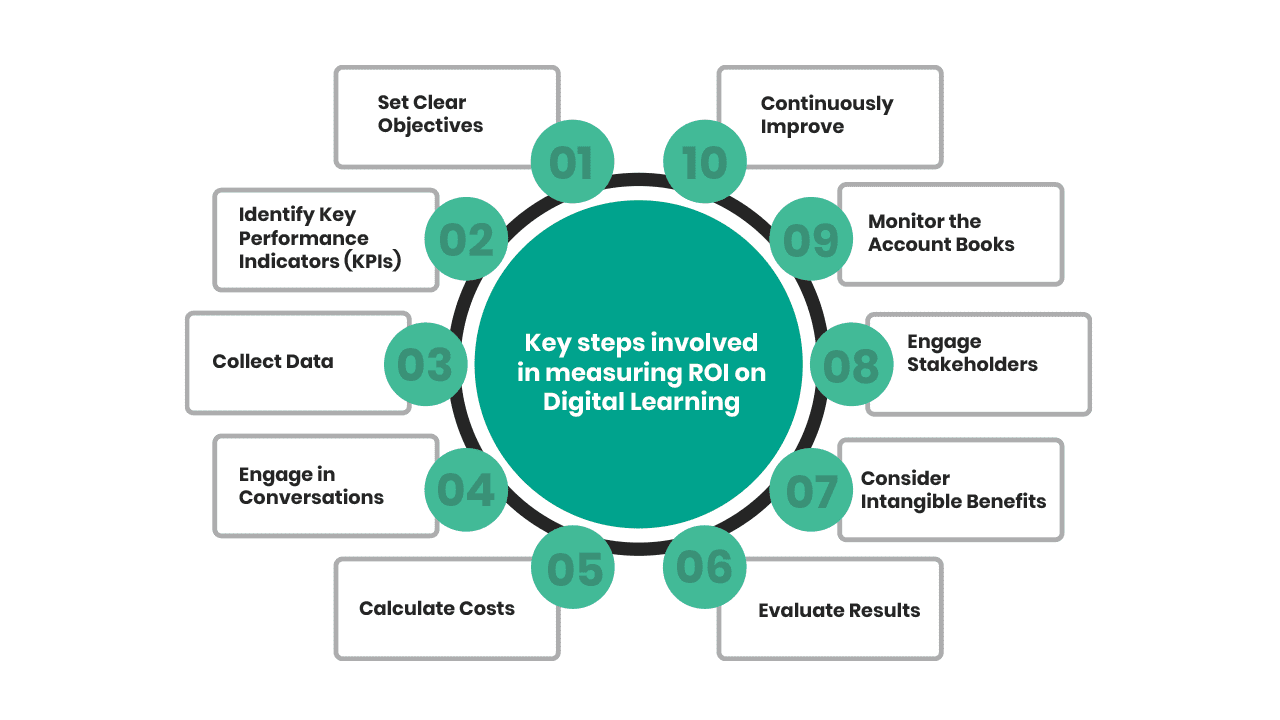In today’s digital age, eLearning has emerged as a powerful tool for training and development in various industries. It offers flexibility, scalability, and cost-effectiveness compared to traditional training methods. However, while training is an important tool for the modern enterprise that significantly impacts the bottom line, measuring the return on investment (ROI) for digital Learning initiatives presents a significant challenge for organisations and Learning and Development professionals.
Determining the effectiveness and value of online training requires a thoughtful approach and the consideration of multiple factors. The following factors highlight the key steps involved in measuring ROI on Digital Learning and how organisations can leverage this to unlock the true potential of their digital learning investments.
1. Set Clear Objectives: The first step in measuring ROI on digital learning is establishing clear and specific objectives for the training. It is important that objectives that are set align with the organisation’s overall goals. For example, if the goal is to improve employee performance, the objectives could be to enhance specific skills or knowledge areas. Setting measurable objectives provides a benchmark against which we can assess the effectiveness of digital learning interventions.
2. Identify Key Performance Indicators (KPIs): Once the objectives are clearly defined, it is essential to identify relevant Key Performance Indicators (KPIs) that organisations can use to track the impact of digital learning initiatives. KPIs can vary depending on the training’s goals. However, common metrics include the following.
- Employee performance improvement
- Knowledge retention rates
- Training completion rates
- Cost savings (compared to traditional training methods.)
By identifying and selecting appropriate KPIs, organisations can gather meaningful data to evaluate the success of their digital learning initiatives.
3. Collect Data: Gathering data is crucial for measuring ROI on digital learning. We can employ various methods to collect relevant data, including pre and post-training assessments, surveys, feedback forms, and inputs from the learning platform’s analytics. Pre-assessments establish a baseline for comparison, while post-assessments measure the improvement in knowledge or skills. Surveys and feedback forms allow participants to share their experiences and provide valuable insights. Analytics from learning platforms provide data on completion rates, time spent on courses, and engagement levels. Collecting comprehensive data sets the foundation for an accurate ROI analysis.
4. Engage in Conversations: Data only sometimes provides the full picture. There are staff who may score poorly at a digital learning summative assessment but go on to apply their newfound knowledge well in a workplace context. We can engage affected employees in conversations to measure this performance success. The engagement can be done as a series of one-to-one, face-to-face chats or a small online focus group, allowing managers or supervisors to look beyond the rigid format of standard questionnaires. In addition, ascertaining if the training has been useful will further help dig deeper into other aspects of the learning experience.
5. Calculate Costs: Organisations must calculate the costs associated with their digital Learning initiatives to determine ROI. These include development costs (content creation and technology), implementation costs (learning platform setup and infrastructure), and ongoing maintenance and support costs. Additionally, consider the charges of trainers or instructional designers in developing interactive digital learning content. By quantifying these expenses, organisations can compare digital learning costs with those for Instructor Led Training (iLT)and ascertain the benefits derived from the training.
6. Evaluate Results: Once the data is collected and costs are determined, it’s time to evaluate the results and calculate the ROI by comparing the KPIs before and after the digital learning programme. For example, if the objective was to improve sales performance, compare the average sales figures of participants before and after the upskilling intervention. Calculate the difference and divide it by the training costs to obtain the ROI percentage. Evaluating results helps organisations understand the impact of digital learning on performance and make informed decisions about future training interventions.
7. Consider Intangible Benefits: While ROI is typically associated with financial returns, it’s important to consider the intangible benefits of digital learning. Improved employee satisfaction, increased engagement, reduced training time, and the ability to reach a geographically dispersed workforce are some intangible benefits that digital learning offers. While these benefits may not be quantifiable, they contribute to the overall ROI value. So be sure to include them as qualitative benefits.
8. Engage Stakeholders: After delivering a learning intervention, asking clients (or some) if they have observed any improvements in their interactions with employees is beneficial. This assessment is true for client-facing businesses. A record system can then collate and identify trends and patterns. Remember that the time it takes to see improvements differs from one training/learning intervention to another. A technical skill improvement may become more easily discernable than a soft-skill improvement. Typically, some organisations allow between 30-180 days for monitoring behaviour changes and skill improvements.
9. Monitor the Account Books: Most organisations are established to generate revenue. Therefore, checking the books is an obvious way to measure ROI in direct profits. However, a reasonable period is required before checking for an uptick in profit or revenue, as it will take a little time for employees to put their new skills to practice. As indicated in 8 above, each organisation needs to agree on how much time to allow before tracking the impact of skill improvements.
10. Continuously Improve: Measuring ROI on digital learning is not a one-time process. It’s a continuous journey of improvement. Organisations should regularly review and analyse the data, gather feedback from participants, and make necessary adjustments to optimise the effectiveness and ROI of their digital learning initiative.
Suppose organisations and learning professionals implement the above suggestions in full. In that case, they can track the ROI on the various digital learning interventions to determine whether they address the issues and meet business goals. This project is challenging but requires deliberate actions to achieve the right results. If they put in the right effort, success awaits them.
Written by:

Christian Edohor
Head of Delivery, Digital Learning

